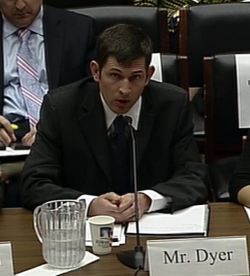This morning I appeared before members of the U.S. Congress to speak about the role of technology and government oversight in Canada's oilsands. As policy director at the Pembina Institute, I was invited along with several others to testify at the "American Energy Initiative" hearing of the Subcommittee on Energy and Power, part of the House of Representatives’ Energy and Commerce Committee.
There were many others witnesses testifying about the history of innovation in the oilsands industry and the many, as of yet, unrealized technologies that may be deployed to improve environmental performance. In my testimony, I sought to draw the Committee's attention to the critical role that regulatory policy can play in driving improved performance.
 Innovation does not occur in a vacuum. It requires the right conditions — the right regulatory and financial signals — to spark innovation and enable companies to remain competitive in the marketplace. For instance, consider the steps taken to address acid rain, the hole in the ozone layer or removing lead in gasoline. Each of these problems had specific regulations in place that catalyzed technological innovation and reduced pollution.
Innovation does not occur in a vacuum. It requires the right conditions — the right regulatory and financial signals — to spark innovation and enable companies to remain competitive in the marketplace. For instance, consider the steps taken to address acid rain, the hole in the ozone layer or removing lead in gasoline. Each of these problems had specific regulations in place that catalyzed technological innovation and reduced pollution.
So far, little attention has been placed on the appropriate role of government in regulating environmental performance in the oilsands sector. As a result, many environmental impacts continue to worsen. While progress is being made in areas such as tailings management — a direct result of new regulations from Alberta's Energy Resources Conservation Board — there is still much work to be done with respect to tailings, reclamation, greenhouse gas emissions, and land and water use.
The Pembina Institute continues to advocate for the policy changes that could be made to improve environmental management in the oilsands. Solving the Puzzle, released last April, outlined 19 recommendations to the government that could help spur innovation and reduce the environmental impacts from the oilsands. In December 2011, Pembina published Responsible Action?, the most comprehensive review of Alberta's climate policies to date, which also outlined recommendations that would send a clear signal to industry to innovate.
A stronger regulatory environment for the oilsands would accelerate technological innovation by providing clear signals to oilsands companies to invest in new research and development. Smart regulations can help make the business case for improved environmental management and raise the playing field for the entire industry. I think that's something we can all agree on.
Simon Dyer is the deputy executive director of the Pembina Institute. He is based in Edmonton.



